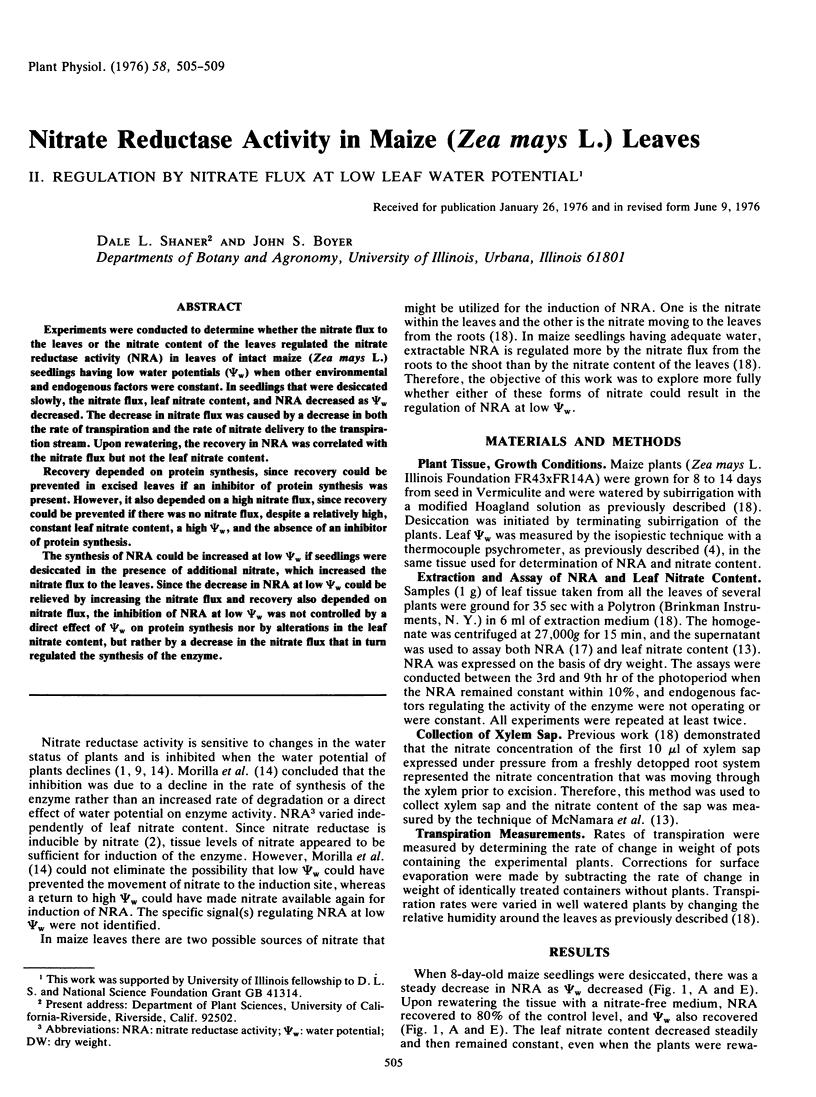Abstract
Experiments were conducted to determine whether the nitrate flux to the leaves or the nitrate content of the leaves regulated the nitrate reductase activity (NRA) in leaves of intact maize (Zea mays L.) seedlings having low water potentials (ψw) when other environmental and endogenous factors were constant. In seedlings that were desiccated slowly, the nitrate flux, leaf nitrate content, and NRA decreased as ψw decreased. The decrease in nitrate flux was caused by a decrease in both the rate of transpiration and the rate of nitrate delivery to the transpiration stream. Upon rewatering, the recovery in NRA was correlated with the nitrate flux but not the leaf nitrate content.
Recovery depended on protein synthesis, since recovery could be prevented in excised leaves if an inhibitor of protein synthesis was present. However, it also depended on a high nitrate flux, since recovery could be prevented if there was no nitrate flux, despite a relatively high, constant leaf nitrate content, a high ψw, and the absence of an inhibitor of protein synthesis.
The synthesis of NRA could be increased at low ψw if seedlings were desiccated in the presence of additional nitrate, which increased the nitrate flux to the leaves. Since the decrease in NRA at low ψw could be relieved by increasing the nitrate flux and recovery also depended on nitrate flux, the inhibition of NRA at low ψ3 was not controlled by a direct effect of ψw on protein synthesis nor by alterations in the leaf nitrate content, but rather by a decrease in the nitrate flux that in turn regulated the synthesis of the enzyme.
Full text
PDF




Selected References
These references are in PubMed. This may not be the complete list of references from this article.
- Bardzik J. M., Marsh H. V., Havis J. R. Effects of water stress on the activities of three enzymes in maize seedlings. Plant Physiol. 1971 Jun;47(6):828–831. doi: 10.1104/pp.47.6.828. [DOI] [PMC free article] [PubMed] [Google Scholar]
- Boyer J. S. Nonstomatal inhibition of photosynthesis in sunflower at low leaf water potentials and high light intensities. Plant Physiol. 1971 Nov;48(5):532–536. doi: 10.1104/pp.48.5.532. [DOI] [PMC free article] [PubMed] [Google Scholar]
- Emmert F. H. Effect of Time, Water Flow, and pH on Centripetal Passage of Radiophosphorus across Roots of Intact Plants. Plant Physiol. 1972 Sep;50(3):332–335. doi: 10.1104/pp.50.3.332. [DOI] [PMC free article] [PubMed] [Google Scholar]
- Morilla C. A., Boyer J. S., Hageman R. H. Nitrate Reductase Activity and Polyribosomal Content of Corn (Zea mays L.) Having Low Leaf Water Potentials. Plant Physiol. 1973 May;51(5):817–824. doi: 10.1104/pp.51.5.817. [DOI] [PMC free article] [PubMed] [Google Scholar]
- Scholl R. L., Harper J. E., Hageman R. H. Improvements of the nitrite color development in assays of nitrate reductase by phenazine methosulfate and zinc acetate. Plant Physiol. 1974 Jun;53(6):825–828. doi: 10.1104/pp.53.6.825. [DOI] [PMC free article] [PubMed] [Google Scholar]
- Shaner D. L., Boyer J. S. Nitrate Reductase Activity in Maize (Zea mays L.) Leaves: I. Regulation by Nitrate Flux. Plant Physiol. 1976 Oct;58(4):499–504. doi: 10.1104/pp.58.4.499. [DOI] [PMC free article] [PubMed] [Google Scholar]


